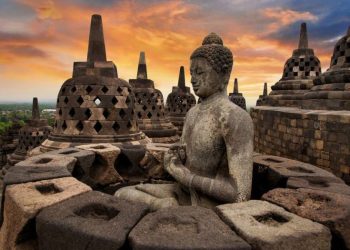By Rivaldi Ihsan, Ethnomusicologist and Lecturer in Music at Sumbawa University of Technology (Instagram: rivaldiihsan, E-mail: ihsanaja361@gmail.com)
The museum of Sutan Ibrahim, whose title is Datuk Tan Malaka, is located in Nagari Pandam Gadang. Tan Malaka was born on June 2, 1897 in Nagari Pandam Gadang Lima Puluah Kota. He is a hero of the national independence of the Republic of Indonesia, the founder of the Indonesian communist party, the Murba party, as well as a militant, radical and revolutionary activist (Muhtar said, 2013: 1). Tan Malaka was born to a father named Rasad Chaniago and a mother named Sinah Simabur. When Tan Malaka was ten years old he enjoyed practicing martial arts, as well as learning religious knowledge at Surau. Armed with martial arts and Islamic teachings, as well as memorizing the Koran, he became a smart figure in the world of education and politics.
In 1908-1913 Tan Malaka had the opportunity to attend the Bukit Tinggi Kweekschool (Dutch teacher school) and received an offer to continue his studies at the Rijkskweekschool (government teacher education school) in Haarlem, the Netherlands. While studying in the Netherlands, Tan Malaka’s self-awareness began to grow, seeing the condition of Indonesia as a Dutch colony. From this experience, he was interested in reading and understanding the concepts of communism and socialism of Karl Marxist, Friedrich Engels, Vladimir Lenin, Friedrich Nietzsche as the beginning of the concept of Madilog and Gerpolek in Indonesia.
Before Tan Malaka left to continue his studies in the Netherlands, he took the time to visit Nagari Talang Anau to perform the ritual of saying goodbye to the old people through the intermediary of the sound of talempong stones. The people of Nagari Pandam Gadang and the people of Nagari Talang Anau have a cultural heritage from their elders. One of them is to perform a ritual of saying goodbye before leaving to migrate to a foreign country by visiting the talempong stone of Nagari Talang Anau, so that when in the overseas land all affairs run smoothly.

Another name for Batu Talempong is sounding stone. Over time, the name change occurred because Nagari Talang Anau also had the art of talempong pacik. The influence of local art gave a new name, namely Talempong Batu Nagari Talang Anau. This stone talempong consists of six pieces with different sizes.
According to the history of the discovery of talempong batu in the 12th century AD by a young man named Samsudin. At that time he dreamed of three consecutive nights discovering stone talempongs around the Nagari Talang Anau river. The stones were scattered around the river adjacent to Nagari Talang Anau. A young man named Samsudin took the initiative to command the rocks using a bamboo tool and a stick. He also took the stones out of the river towards Nagari Talang talempong stones gathered in Nagari Talang Anang is now a cultural heritage site.
The uniqueness of the stone talempong in Nagari Talang Anau is as follows; First, the shape of the stone is irregular with a length of one to one and a half meters, secondly it consists of six stones with different types of length and width, thirdly the stone talempong produces a sound source with a stone beater as well, four if borrowing the concept of western music, the stone talempong produces the tone D Dis Fis Cis Fis Ais with interlocking playing techniques or connecting tones, the higher the feeling of the musician playing the stone talempong, the higher the tones it produces. Five, the only talempong batu is only found in Nagari Talang Anau West Sumatra.
The talempong batu performance usually begins with burning incense first by a talempong batu player. Incense as a sign of permission, respect, and appreciation for the previous elders, especially Samsudin. The burning of incense at the talempong batu location is believed by the people of Talang Anau. That, if there are guests or visitors who want to watch the talempong batu play, they must first burn incense around the talempong batu. If they do not burn incense, before playing the talempong batu there will be a warning from the previous parents.
Here’s an excerpt from the history of talempong batu:
In the 12th century AD these talempong stones were discovered and collected by a young man named Samsudin. The story goes that before Samsudin found these stones. He had three dreams, in which a number of points of light appeared that illuminated the darkness in his area. In the first dream Samsudin ignored it, but after experiencing it three times in a row. It was as if there was an order from the ancients to look for these bright points of light. Finally Samsudin began to walk around the area where he lived. After walking around Samsudin felt tired and immediately rested. When he rested he sat pensively and thought about what exactly he was looking for. While sitting Samsudin banged his stick on a rock in front of him. Samsudin was surprised that the stone in front of him could produce sound. He continued to search the points of light in his dream for other stones. With a stick of green coconut leaves heading somewhere and collecting it over the mouth of a hole or tunnel that stretches long towards a large enough spring now called mandau water just west of Nagari Talang Anau, all the stones are collected and arranged on two bamboo poles that cross over the mouth of the hole. The stones collected by Samsudin can make a sound, so the people of Talang Anau use stones as a medium for gathering the population and a means of entertainment. (quoted from Rizal Afrizal, November 8, 2017, in Nagari Talang Anau).
From the description above, it explains a discourse about the heritage site from the stone age in Nagari Talang Anau. A culture recognized by the local community through ideas, activities, and artifacts. First, the idea of a culture is the idea of playing talempong batu with interlocking techniques or connecting tones. Such as paningkah one, paningkah two, and paningkah three. Second, activities related to the customs in Nagari Talang Anau, namely the talempong batu performance held in Nagari Talang Anau according to needs can be ritual or entertainment. Third, the artifact, namely the stone talempong which is a symbol of Nagari Talang Anau Lima Puluah Kota.
The structure consists of nature in the form of Nagari Talang Anau, the Talang Anau Community, the history of the oral tradition of Samsudin, the inventor of talempong batu, and the performance of talempong batu which can be ritual and entertainment. Talempong batu players are local people. Talempong performances are only performed in Nagari Talang Anau. If you want to enjoy the show, visitors who visit Nagari Talang Anau.
Borrowing the discipline of Ethnomusicology or a scientific discipline that studies music in the socio-cultural context of Nagari Talang Anau. Then the use and function of talempong batu Nagari Talang Anau will be clearly seen. When we talk about the use of music, we refer to the ways music is used in society, as an ordinary practice carried out as part of the implementation of traditional ceremonies, both in terms of the activity itself, and in relation to other activities (Merriam, 1964: 210). Use indicates the situation of music used in human activities.
Function relates to the reasons why the user performs, as well as goals that go beyond what it can serve. Thus, use is more related to the practical side, namely talempong batu Nagari Talang Anau in the past was used as a ritual ceremony to ask permission from the old people. The ritual was performed before leaving to say goodbye, in order to be given safety while in the overseas land. While the function is more related to the text and internal cultural context in Nagari Talang Anau.
Merriam describes ethnomusicologist research as having ten functions. 1. as emotional expression, 2. as aesthetic appreciation, 3. as entertainment, 4. as communication, 5. as symbolism, 6. as physical reaction, 7. as related to social norms, 8. as validation of social institutions and religious ceremonies, 9. as cultural continuity, 10. as community integration (Merriam, 1964: 209-227).
First, talempong batu functions as an emotional expression, for fellow Nagari Talang Anau people. Second, talempong batu as an appreciation of aesthetic values, if the player plays with appreciation then the aura of talempong batu will come out. Third, talempong batu serves as entertainment for visitors to the cultural heritage in Nagari Talang Anau. Fourth, talempong batu serves as communication with the spirits of the old people. Five, talempong batu as a symbol to gather the people of Nagari Talang Ana. Six, talempong as a physical reaction, when talempong batu is played, the bodies of players and spectators move to the rhythm of the talempong batu, the head nods or the feet do small stomps on the floor.
Seven, talempong batu is related to social norms believed by the people of Talang Anau, that when playing talempong batu, they must first ask permission from the spirits of previous parents. Eight, talempong batu as a social and religious ceremony, talempong batu functions as a ritual to ask for permission to previous parents believed to be guardians, callers, and warders from danger. Nine, talempong batu as a cultural continuity of the Nagari Talang Anau community by collaborating bronze talempong with stone talempong at traditional ceremonies in Nagari Talang Anau, so that the younger generation is interested in appreciating and learning. Ten, as an integrating place for the people of Nagari Talang Anau to interact and gather when the talempong batu performance is taking place.
From the field notes above, it can be concluded that a culture is always structured systematically closely interrelated with a unity of physical and non-physical aspects. Non-physical in the form of ideas, oral literature that is believed while physical in the form of society, talempong batu in Nagari Talang Anau. This structure is present through ideas, activities, and artifacts of the people of Nagari Pandam Gadang and Nagari Talang Anau. Art as part of culture cannot be separated from its supporting community. With the support of the local community, the identity is formed as well as a differentiator from cultural arts in other areas. Therefore, it takes the role of the community to maintain and preserve cultural arts in the Nagari Talang Anau area.
























